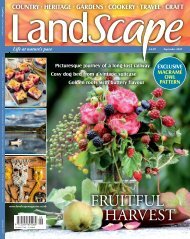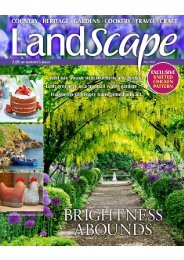Create successful ePaper yourself
Turn your PDF publications into a flip-book with our unique Google optimized e-Paper software.
Contents<br />
August 2022<br />
48<br />
96<br />
In the garden<br />
In the kitchen<br />
26<br />
Craft<br />
12 Harmonious lochside croft garden<br />
22 The garden in August<br />
26 Intricate detail of exotic climbers<br />
38 Silver foliage for summer shimmer<br />
48 Botanical bakes with delicate flavour<br />
56 Golden parcel of succulent flakes<br />
60 Sweet bell peppers for bold dishes<br />
66 Regional & Seasonal:<br />
Gilchesters Organics,<br />
Northumberland<br />
42 Rainbow displays of gladioli spears<br />
82 Nutritious soap crafted from nature<br />
94 Stationery with a colourful twist<br />
96 Comfort in a carry cushion<br />
100 Preserving pretty petals<br />
124 Readers share their creative talents<br />
4
104 82 42<br />
70<br />
Countryside<br />
History and heritage<br />
Regulars<br />
114 The countryside in August<br />
116 Hidden world revealed along the<br />
rocky shoreline<br />
70 On the trail of Wiltshire’s<br />
mysterious white horses<br />
104 Strength and beauty in an ancient<br />
building skill<br />
6 Readers’ letters<br />
8 Our LandScape<br />
35 In the garden<br />
40 Subscription offer<br />
58 In the kitchen<br />
92 In the home<br />
5
LOCHSIDE GEMS IN<br />
A CROFT GARDEN<br />
The owners of a traditional Highland home have made the most of<br />
its far-reaching views with softly hued plantings from exotic climes,<br />
which meld with the stunning landscape
48
SPRINKLED WITH THE<br />
TASTE OF SUMMER<br />
Petals and herbs provide pretty, colourful garnishes as well as delicate<br />
flavour to botanical bakes, which are perfect for a sunny day<br />
FOR A SEASONAL touch, botanicals, such as<br />
edible flowers and summer herbs, not only add<br />
decoration and colour to a variety of sweet treats,<br />
but also texture and flavour.<br />
There is a host of flowers to choose from, such as<br />
dianthus, daisy, elderflower, nasturtium, viola and rose,<br />
but it is important they are identified properly before<br />
eating. Faded, dusty roadside flowers should be avoided<br />
as well as those growing in areas frequented by livestock<br />
or dog walkers, and they should always be free from<br />
pesticides. Care should be taken if bees are about, and<br />
the blooms checked and cleaned for small insects.<br />
Picking young flowers in the morning before the sun<br />
warms up ensures an intensity of colour and flavour.<br />
Herb flowers, including basil, chives, lavender, mint,<br />
rosemary and thyme, impart a more subtle flavour to<br />
food than their leaves.<br />
For best results, flowers should be used immediately<br />
or refrigerated in a plastic bag for 2-3 days. Dried or<br />
frozen flowers can also be bought for culinary purposes.<br />
Flower ring biscuits<br />
Makes 20<br />
10g mixed edible flowers, such<br />
as pansies, violas, daisies and<br />
rose petals, torn or pulled apart<br />
into small pieces<br />
1 tsp dried lavender<br />
2 tbsp rose water<br />
230g cold unsalted butter, cubed<br />
200g caster sugar<br />
1 egg<br />
450g plain flour<br />
1 tsp baking powder<br />
115g icing sugar<br />
30ml double cream<br />
2 drops yellow food colouring<br />
large, flat oven tray<br />
baking paper<br />
7cm round cookie cutter and<br />
2cm round cookie cutter<br />
Line the oven tray with baking paper. In a food processor, whisk together the<br />
butter and caster sugar for 2-3 mins until thick and creamy. Beat in the egg<br />
and 1 tbsp of rose water, then mix in the flour and baking powder.<br />
Cut 2 large sheets of baking paper and place one on a clean kitchen<br />
surface. Place the mixture onto the baking paper on the kitchen surface and<br />
top with the other piece of baking paper. Roll the mixture with a rolling pin,<br />
keeping the top piece of baking paper in place, until the mixture forms a<br />
1cm-thick rectangle. Cut out as many large circles as possible, using the<br />
larger cutter, and transfer them to the prepared tray, spacing them out from<br />
each other 1cm apart. Use the smaller cutter to remove a circle of dough<br />
within each biscuit and discard or add to the remaining dough to re-roll so<br />
there are 20 biscuits. Place the tray in the fridge for 30 mins until the<br />
biscuits are firm.<br />
Preheat the oven to 180°C/160°C fan/gas mark 4. Bake the biscuits for<br />
15-20 mins until golden and firm. Allow to cool slightly, then transfer to a<br />
wire rack to cool completely.<br />
To make the icing, combine the icing sugar, remaining rose water, double<br />
cream and yellow food colouring in a large, shallow dish. Stir the icing until<br />
very smooth, then dip the biscuits in the icing horizontally so that the tops<br />
are covered. Place on the wire rack, then top with the edible flowers and<br />
dried lavender. Allow to dry completely before serving.<br />
49
MYSTERIOUS PAST OF<br />
THE HILLSIDE HORSES
Carved into the rolling, chalky landscape, Wiltshire’s<br />
giant white equines are a fascinating draw to this<br />
rural county and an enduring presence watching<br />
over communities through the centuries<br />
The white horse at Alton Barnes<br />
in Wiltshire appears to be<br />
moving across the slopes behind<br />
golden pyramids of neatly<br />
stacked hay bales; their shape<br />
mirroring the rolling hills.
LIFE ALONG THE<br />
ROCKY SHORE<br />
With the ebbing of the tide, a hidden world is revealed<br />
in pools and fissures, populated by fascinating creatures<br />
adapted to surviving where land meets sea<br />
THE TIDE IS going out at<br />
Wembury Beach in Devon, and<br />
the sea is a surge of white and blue<br />
as it rolls and swells against the<br />
rocks, spilling up gullies and clefts as it is<br />
pulled slowly, inexorably, away. A new<br />
world emerges in its wake; sunlight<br />
trickling across the flat, wet sand; seaweed<br />
piled in ragged lines along the shore.<br />
Mounds of black rock that once lay<br />
beneath the waves are now exposed in the<br />
briny wind that glances round the cove,<br />
their reflections glimmering in the pools of<br />
water that ring their feet.<br />
The sea lingers too, in the ridges and<br />
channels that ruck the cliffs, in cracks and<br />
crevices, and in the dips of soft sand<br />
around sea-scoured boulders. Here remain<br />
secret, sunken worlds of spiky, leggy<br />
animals, of stalked mouths, goggling eyes<br />
and beaked and rippled shells. Rock pools<br />
are endlessly fascinating; at first sight,<br />
seemingly empty, but patience is rewarded<br />
as a sudden flurry of sand or a twitch of<br />
weed hints at the marvels within.<br />
Ben Holt, of the<br />
Cornwall- and<br />
Devon-based<br />
wildlife group<br />
The Rock Pool<br />
Project.<br />
Shifting sands<br />
The animals of the rugged shoreline are<br />
not here by chance, as strays abandoned by<br />
the ocean, but are part of a highly<br />
specialised community primed to survive a<br />
world in flux. The beach is an environment<br />
of constant change, with its inhabitants<br />
buffeted by the waves at every tide as they<br />
swing between the relatively constant<br />
conditions of the sea and the fickle world<br />
of the sands.<br />
“The rock pool environment is harsh,”<br />
says Ben Holt, of community wildlife<br />
group The Rock Pool Project. “In summer,<br />
the water in a pool could be as high as<br />
30°C, but in winter, it can be close to<br />
freezing. At higher temperatures, all the<br />
oxygen in the water will be quickly used<br />
up, and when the sun shines, the UV<br />
exposure will be high. On a hot day,<br />
evaporation will make the water more<br />
saline, but if it rains or an inland creek fills<br />
and flows onto the beach, salty seawater<br />
can become fresh.”<br />
The ability to cope with these<br />
challenges leads to a natural sorting: a<br />
gradient of species stretching from the top<br />
of the shore to the low tide mark. “The top<br />
of the beach is exposed to the air most of<br />
the time, perhaps only becoming<br />
submerged at very high tide,” explains<br />
Ben. “This is very different from further<br />
down, which might be underwater for ❯<br />
Microhabitats are formed among the rocks as the tide<br />
recedes on Wembury Beach. The Great Mewstone, now a<br />
nature reserve, can be seen in the distance.<br />
116
The distinctive blister-like air<br />
sacs of bladder wrack, Fucus<br />
vesiculosus, allow it to float<br />
upright when submerged.<br />
The bright blue beads of the Beadlet anemone,<br />
Actinia equina, are packed with stinging cells.<br />
Young fish, such as these herring fry, may<br />
also become trapped in rock pools.<br />
Dead man’s fingers corals, Alcyonium digitatum<br />
surround an aggregation of the instantly<br />
recognisable Common starfish, Asterias rubens.
Glinting in the summer sunshine,<br />
flint-covered cottages, with<br />
their windows picked out in<br />
contrasting red brick, line the<br />
village centre at Burnham<br />
Market in North Norfolk.<br />
TEXTURED WALLS<br />
IN ANCIENT STONE
PINK AND YELLOW roses scramble over the<br />
bumpy, textured walls of a row of flint cottages in<br />
Burnham Market, Norfolk. With egg shapes and<br />
amorphous circles of blue-black, tawny brown, milky<br />
grey and flecked rust, the protruding flints contrast with neat<br />
flat-brick lintels around the windows and doorways, and the<br />
evenly scalloped edges of warm terracotta clay roof tiles.<br />
Fronted by a misty purple lavender hedge and tall hollyhocks<br />
nodding in the summer breeze, these highly distinctive<br />
cottages have not changed significantly since they were built<br />
in the 17th and 18th centuries. “England has perhaps no<br />
more curious material than flint: a stone of obscure origin,<br />
quite unlike any other in colour and texture, and not used for<br />
building in any other country on so extensive a scale,” writes<br />
Alec Clifton-Taylor in The Pattern of English Building.<br />
Flint is one of the most common, naturally occurring<br />
stones in southern Britain. It is a type of quartz, or crystalline<br />
silica, with a cryptocrystalline structure, which means the<br />
crystals are so tiny that they are difficult to see, even when<br />
viewed under a microscope.<br />
Traditional flintwork can add shine,<br />
colour and a rugged appeal to<br />
buildings and ornamental features,<br />
and is a skilled craft that has<br />
endured through the centuries<br />
Early uses<br />
Flint was used by prehistoric man, initially for rudimentary<br />
tools and weapons, and there is a 93-acre, 5,000-year-old flint<br />
mine at Grime’s Graves in Norfolk as evidence of its early<br />
importance. The Romans spotted its durable properties and<br />
used it to strengthen the walls of their forts, such as<br />
Anderida, on the site of Pevensey Castle in East Sussex. The<br />
availability and resilience of flint meant that it continued to<br />
be popular in the Middle Ages, when brickmaking was<br />
uncommon, and other stone was hard to find or difficult to ❯<br />
105
Subscribe to LandScape<br />
Every issue of LandScape is filled with the very best that Britain has to offer, including delicious<br />
recipes, inspirational gardens, step-by-step craft projects and much more.<br />
In addition to having this beautiful magazine delivered directly to their door for free, subscribers<br />
this month can take advantage of the special price of just £4.30 a month.<br />
Call our order hotline on 01858 438884 and quote offer code CIAA<br />
Lines open Mon-Fri 8am-9.30pm, Sat 8am-4pm<br />
Terms & Conditions: Subscriptions will start with the next available issue. The minimum term is 12 months (12 issues). You will not receive a renewal reminder when paying by Direct Debit, and payments will continue<br />
to be taken unless you tell us otherwise or cancel this at your own bank. This offer closes on 30 September 2022. This offer cannot be used in conjunction with any other offer. This offer is only available when you subscribe<br />
directly with the publisher (Bauer Media) by phone or on our website (Great Magazines). Cost from landlines for 01 numbers per minute are (approximate) 2p to 10p. Cost from mobiles per minute (approximate) 10p to<br />
40p. Costs vary depending on the geographical location in the UK. You may get free calls to some numbers as part of your call package – please check with your phone provider. Order lines open 8am-9.30pm (Mon-Fri),<br />
8am-4pm (Sat). UK orders only. Overseas? Phone +44 1858 438828. Calls may be monitored or recorded for training purposes. For full terms and conditions, please visit: www.greatmagazines.co.uk/offer-terms-and-conditions.
for just £4.30 a month<br />
Dear reader...<br />
I<br />
HOPE YOU ARE<br />
enjoying this issue of<br />
LandScape magazine.<br />
If you are, and you<br />
would like to take out a<br />
subscription, you can do so<br />
for only £4.30 a month.<br />
There is so much to<br />
celebrate in the British<br />
countryside, from seasonal cookery to beautiful<br />
gardens. Every issue, we bring you people who<br />
follow in the footsteps of generations to create<br />
inspiring traditional crafts. We focus on the<br />
wonder of Britain’s landscape and its plants<br />
and animals.<br />
Subscribing is easy. If you sign up today, you<br />
can take advantage of this special offer, and you<br />
will never miss an issue. A subscription to<br />
LandScape would also make a perfect gift.<br />
* Pay £4.30 by monthly recurring Direct Debit<br />
Rachel Hawkins<br />
Editor<br />
TWO GREAT PACKAGES<br />
Print<br />
Pay £4.30 by monthly<br />
recurring Direct Debit*<br />
12 issues for £48 when you<br />
pay by annual Direct Debit<br />
Digital<br />
Pay £2.30 by monthly<br />
recurring Direct Debit<br />
12 issues for £24 when you<br />
pay by annual Direct Debit<br />
12<br />
issues<br />
a year<br />
Subscribe today and enjoy these benefits:<br />
• Save money on shop prices<br />
• Access anywhere, anytime on your smartphone or tablet with a digital subscription<br />
• Never miss an issue<br />
Subscribe securely online: www.greatmagazines.co.uk/ls<br />
41
















